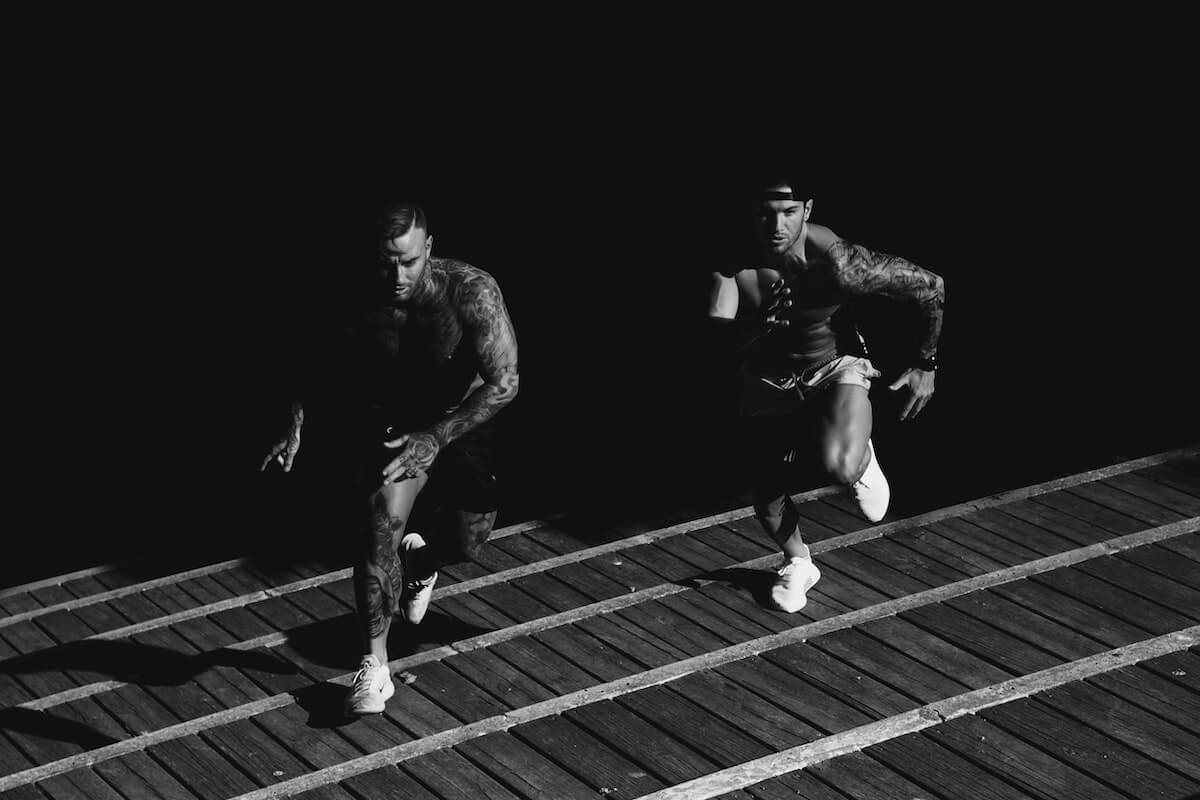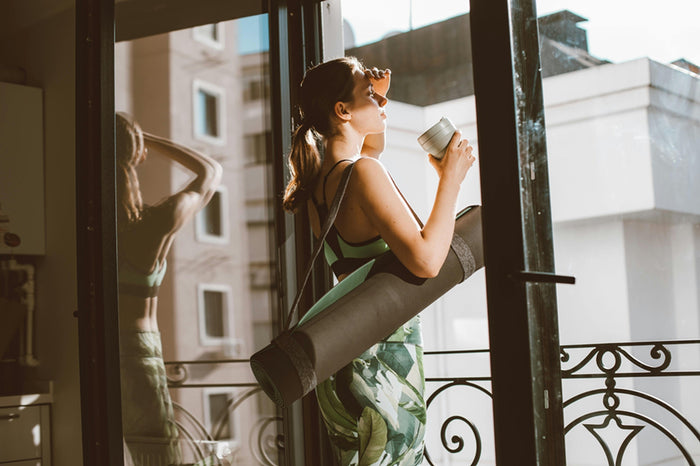Cardio training is one of the most popular forms of exercise, and experts recommend getting at least 150 minutes of moderate aerobic exercise, or 75 minutes of vigorous activity each week.
Whether it’s running, cycling, skipping, or HIIT classes, the variety of options means there’s something for everyone. There's a plethora of health benefits when it comes to cardio, so it’s important to try and get some into your fitness routine.
How to get better at cardio
If you’re not used to cardio-style workouts, it can be hard to know where to start when it comes to improving your performance. Alternatively, if you’ve been doing cardio for a while now and want to take it up a notch, it can be just as difficult to know how to really boost your performance.
Cardio of benefits
The benefits of doing regular cardio are well-documented and near endless. They include:
- Improved mood
- Increased energy
- Increases your circulation
- Helps clear your skin
- Benefits brain health
- Keeps your joints flexible
- Improves blood sugar control
With that in mind, we’ve put together a list of some top tips anyone can adopt to seriously set their cardio training in motion. Whether you’re a beginner or a total pro, these easy steps could be the key to transforming your fitness routine.

How to boost cardio endurance
- Set gradual, achievable targets
No one's a professional at anything from the off, so don’t expect to be able to run a marathon within weeks of starting to boost your cardio training. Increase the intensity of your workouts slowly; muscles and joints take longer to adapt to the stress of exercise than your heart and lungs. If you're running or cycling, don’t increase your time or distance by more than 10-20% each week, in order to avoid injury.
So, if you start out with 10 minutes of exercise, add on one or two minutes each time for the first few weeks before making your progressions slightly larger.
It’s also a good idea to keep a journal or diary where you can record and keep track of your fitness goals and achievements. You can either write these down on paper, or use a fitness app to help you.
Apps can help you track your steps, heart rate, nutrition and more, so if you’re looking to take your cardio training that bit more seriously, it’s a no-brainer. You can see the results in front of your eyes. There have even been studies that have shown that smartphone apps and exercise trackers can help improve fitness.
What the Innermost Insiders say:
“I’d advise anyone looking to improve their cardio performance to set themselves little targets. Preparing for the London Marathon, I would run one short run (e.g. two miles) and one longer run per week (e.g. six miles), giving myself enough time to recover between the runs. With practice, and after a couple of months, they both became six miles, and then 10 to 15 miles.” - Zack Seamons
- Interval training
Interval training has been used for years by athletes looking to improve and build upon their fitness. It usually entails combining short, high-intensity bursts of speed with slow recovery phases, and doing this in alternation throughout one exercise session. Essentially, interval training can help you boost your cardio performance by working both the aerobic and anaerobic systems.
During periods of high-intensity (such as during interval training), the anaerobic system uses the energy stored in the muscles (glycogen) for short bursts of activity. The anaerobic metabolism is able to work without oxygen, however the by-product created is lactic acid.
As lactic acid builds, we enter what’s known as ‘oxygen debt’, and it’s during the recovery phase that our heart and lungs work together to ‘pay back’ this oxygen debt and break down the lactic acid. It’s in this phase that the aerobic system is using oxygen to convert stored carbohydrates into energy.
Ultimately, it's thought that by doing high-intensity intervals that produce lactic acid, the body learns to adapt and burn lactic acid more efficiently during exercise, hence improving our performance during cardio.
In addition, here are some of the several other benefits of interval training:
- More calories burned. If you’re looking to lose body fat, intervals are more effective than long, slow endurance exercise. The effort you have to put in means your body will have to work harder to recover, so you’ll burn more calories in the 24 hours after a session of interval training than you would after a long, slow, steady run.
- A healthier heart. Did you know HIIT can actually decrease strain on your heart? Over time, cardio exercise can increase your heart stroke volume, making your heart stronger and more efficient. This can also decrease your risk of both heart disease and high blood pressure.
What the Innermost Insiders say:
“For me, I try to change it up each session so as to not stagnate my cardio training. So if I go for a long run on Monday, I’ll do interval training on Tuesday, just to make sure you're shocking the body and not making it get used to a specific exercise.” - Darren Placid
- Combine cardio with strength training
Life is all about balance. So even if your main fitness goal is to boost your cardio performance, it’s important to switch things up every now and again, and combining cardio with strength training can actually help you reach those goals in the long run. Strength training helps our muscles become stronger and more powerful, making us ready for those intense cardio sessions. But, it can even help reduce the chances of health problems like osteoporosis, and the symptoms of things like diabetes, obesity, and back pain. But beyond that, it’s good for you mentally too. Researchers have found that strength training can improve brain cognition, reduce anxiety and depression, and boost self-esteem.

Try this easy-to-follow strength and cardio workout from Whole Life Challenge to get you started.
It’s easiest to do this one if you have access to a treadmill in a gym, but any outside space will do perfectly too.
- 5-minute warm up walk
- 90-second jog
- 30-second sprint
- 10 press-ups
- 10 bodyweight squats
- 90-second jog
- 30-second sprint
- 20 walking lunges (10 each side)
- 60-second plank
- 20 mountain climbers
- 90-second jog
- 30-second spring
- 10 burpees
- 60-second wall sit
- 10 squat jumps
- 90-second jog
- 30-second sprint
- 5-minute cool down walk
- Make time to rest and recover
Even though the cardio training itself is what we’re focusing on here, rest and recovery is just as crucial to the process of boosting your performance. Proper rest and recovery allows your muscles to repair themselves so they’re well-prepared and stronger for your next session. If you over train and tire yourself out, it can actually end up having the adverse effect and increase chances of strain and injury.
Here’s some of the best ways you can recover post-workout to ensure your cardio performance is at its best:
- Rest. No, really. You can boost your performance just by sleeping. Sleep is one of the most important factors in our health and fitness, and getting the right amount of quality sleep is crucial to efficient recovery.
- Hydrate. Drink plenty of water throughout the day after your workout to replace all the minerals and nutrients lost through sweat. And if you’re looking to really maximise your recovery, try The Power Booster. Containing creatine monohydrate (one of the most popular sports supplements in the world which increases power, strength and speed), it’s perfect for after high-intensity training.
- Stretch. Stretching helps the muscles stay strong and supple, minimising the chances of tightness and injury. Having a hot shower or bath before stretching can also help loosen the muscles even more prior to stretching.
Looking for some inspiration? Check out these nine easy stretching exercises.

- Fuel your body properly
Without proper fuel, our bodies simply cannot perform at their best. However, sometimes it can be hard to know what our bodies need at which moments. And different types of exercise can require different types of fuel. Barbara Lewin, RD, a sports nutritionist who works with professional athletes, told Health.com: “What’s healthy on a regular basis is not necessarily a good choice for the race course, or even for a workout.”
So for cardio, when you eat is just as important as what. It’s recommended to have a pre-workout meal that’s low in fat and sugar, moderate in protein, and high in carbs. So something like a protein smoothie made with berries about 60 to 90 minutes before you workout would be perfect. This ensures you’ve digested the food properly, while the high-carb content will provide you with enough energy to power you through the session. About 20-30 minutes after your workout, in your body’s ‘metabolic window’, opt for a carb and protein-heavy snack. The protein will help rebuild muscles, while the carbs will replace muscle glycogen stores and replenish energy.
Examples of some snacks you could have include things like:
- A protein shake with fruit. Try one of our Innermost proteins to get all the post-workout goods you need.
- Greek yoghurt with berries.
- A bagel with eggs.

What the Innermost Insiders say:
“I always make sure there’s enough energy in the tank. One of my biggest runs (20 miles in two hours and 20 minutes) was actually completed shortly after an Easter Sunday family meal. Eat light, allow time to digest, and don’t run on empty. I’d also advise eating clean, no fatty foods, no carbonated drinks, and little to no alcohol.” - Zack Seamons
Summary
Think you're a bit more clued up on how to boost your cardio endurance, now? If you try out any of these hacks for boosting your cardio training and performance, let us know, We’d love to hear from you!
























